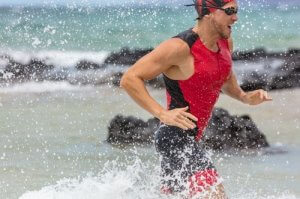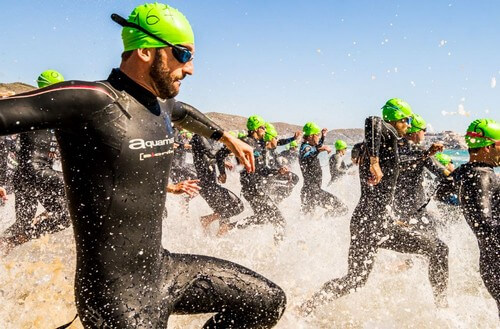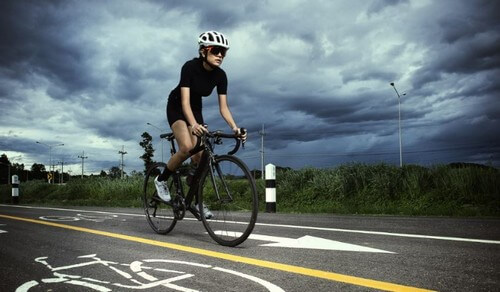Keys to Competing in a Triathlon

Competing in a triathlon is an athletic test that’s aimed at finding the sport’s “Ironman”. In other words, it’s designed for high-performance athletes. As a result, it has its place in the Olympic games. In this article, we’ll take a look at what you should keep in mind before competing in a triathlon.
Competing in a triathlon: origins
The story goes that a group of seamen argued about which person would be the best athlete. They wondered who would have the best endurance – a swimmer, cyclist, or runner? Finally, someone asked, “Why don’t we find out in a multisport race?”
And so the first triathlon was born. Later, starting in 2000, the triathlon was part of the Olympics for the first time in Sydney, Australia.

What is a triathlon?
The event covers three sports back-to-back in an established order – swimming, cycling, and running. There are two transitions, known as the T1, which is when you go from swimming to cycling. Then, there’s the T2, which is when you go from cycling to running.
Keys to competing in your first triathlon
If you’re going to partake in a triathlon for the first time, you should consider these key points:
- If you’re a beginner, you should come up with realistic goals that you can reach.
- Enroll in the event well ahead of time to reduce stress and to get used to the idea of taking part in it.
- Live the triathlon experience to its fullest. If it’s your first time, the important thing is to finish the race and not in which place you came.
- Keep a good attitude to face the challenges that may come up during the event.
- Finally, focus on yourself and not the other athletes. Comparisons won’t help you to achieve your goal of making it to the finish line.
Want to know more? Swimming Stroke: Which Provides the Best Muscle Workout?

Three tips for triathlon trainees
These tips will get your head in the right place so you can get started in this intense discipline:
Workout frequency
Indeed, triathlons are challenging; as such, your body needs time to gain endurance. Don’t wear yourself out training so much that you faint or are in so much pain that you can’t keep training.
Find out more: The Importance of Rest for Health
Intensity
As a beginner, your intensity level might be between low and medium. So, you’ll need to train about three to four days a week. This rhythm will give your muscles and tendons enough time to rest.
Choosing a competition
You’ll build endurance with long-term training. As a result, you should choose a short-distance race for the first time. When training for a triathlon, you should start slowly in swimming, cycling, or running.
Gear you’ll need in a triathlon
So, you already know that this event has three competitions. As such, you should be able to participate in the three following sports:
Swimming
You’ll be swimming freestyle in open water. Since people tend to train in pools, you’ll need a one-piece swimsuit, goggles, and cap to cover your hair.
Cycling
You’ll need clothes that don’t cause friction when pedaling. In sports stores, there’s sportswear with a padded crotch area. To start at a good pace, try pedaling between 80 and 90 RPMs per minute. Practice at home or at the gym with a stationary bike.
Running
Make sure your running shoes are the right size. Though they should be snug, they should also be comfortable. Ask seasoned competitors for their opinion on the most suitable clothing for each sport.

Training
Determine how much time you’ll have each day to train and from there start as follows:
- Dedicate one day to each sport. Then, you’ll be able to alternate.
- Split your time into three sessions: swimming, cycling, and running.
- Do an easy session followed by two harder ones.
- Try three swimming sessions, two cycling sessions, and two running sessions.
- Each week, increase their time and intensity by 10 percent.
- Alternate with breathing exercises.
- Keep in mind to prepare for the transitions.
- Practice movement coordination exercises. You’ll need them for swimming and cycling.
Finally, don’t expect to be completely prepared for your first triathlon. Visit before the organizers get together. Then, try to get familiar with the route and the transition periods.
Competing in a triathlon is an athletic test that’s aimed at finding the sport’s “Ironman”. In other words, it’s designed for high-performance athletes. As a result, it has its place in the Olympic games. In this article, we’ll take a look at what you should keep in mind before competing in a triathlon.
Competing in a triathlon: origins
The story goes that a group of seamen argued about which person would be the best athlete. They wondered who would have the best endurance – a swimmer, cyclist, or runner? Finally, someone asked, “Why don’t we find out in a multisport race?”
And so the first triathlon was born. Later, starting in 2000, the triathlon was part of the Olympics for the first time in Sydney, Australia.

What is a triathlon?
The event covers three sports back-to-back in an established order – swimming, cycling, and running. There are two transitions, known as the T1, which is when you go from swimming to cycling. Then, there’s the T2, which is when you go from cycling to running.
Keys to competing in your first triathlon
If you’re going to partake in a triathlon for the first time, you should consider these key points:
- If you’re a beginner, you should come up with realistic goals that you can reach.
- Enroll in the event well ahead of time to reduce stress and to get used to the idea of taking part in it.
- Live the triathlon experience to its fullest. If it’s your first time, the important thing is to finish the race and not in which place you came.
- Keep a good attitude to face the challenges that may come up during the event.
- Finally, focus on yourself and not the other athletes. Comparisons won’t help you to achieve your goal of making it to the finish line.
Want to know more? Swimming Stroke: Which Provides the Best Muscle Workout?

Three tips for triathlon trainees
These tips will get your head in the right place so you can get started in this intense discipline:
Workout frequency
Indeed, triathlons are challenging; as such, your body needs time to gain endurance. Don’t wear yourself out training so much that you faint or are in so much pain that you can’t keep training.
Find out more: The Importance of Rest for Health
Intensity
As a beginner, your intensity level might be between low and medium. So, you’ll need to train about three to four days a week. This rhythm will give your muscles and tendons enough time to rest.
Choosing a competition
You’ll build endurance with long-term training. As a result, you should choose a short-distance race for the first time. When training for a triathlon, you should start slowly in swimming, cycling, or running.
Gear you’ll need in a triathlon
So, you already know that this event has three competitions. As such, you should be able to participate in the three following sports:
Swimming
You’ll be swimming freestyle in open water. Since people tend to train in pools, you’ll need a one-piece swimsuit, goggles, and cap to cover your hair.
Cycling
You’ll need clothes that don’t cause friction when pedaling. In sports stores, there’s sportswear with a padded crotch area. To start at a good pace, try pedaling between 80 and 90 RPMs per minute. Practice at home or at the gym with a stationary bike.
Running
Make sure your running shoes are the right size. Though they should be snug, they should also be comfortable. Ask seasoned competitors for their opinion on the most suitable clothing for each sport.

Training
Determine how much time you’ll have each day to train and from there start as follows:
- Dedicate one day to each sport. Then, you’ll be able to alternate.
- Split your time into three sessions: swimming, cycling, and running.
- Do an easy session followed by two harder ones.
- Try three swimming sessions, two cycling sessions, and two running sessions.
- Each week, increase their time and intensity by 10 percent.
- Alternate with breathing exercises.
- Keep in mind to prepare for the transitions.
- Practice movement coordination exercises. You’ll need them for swimming and cycling.
Finally, don’t expect to be completely prepared for your first triathlon. Visit before the organizers get together. Then, try to get familiar with the route and the transition periods.
This text is provided for informational purposes only and does not replace consultation with a professional. If in doubt, consult your specialist.








